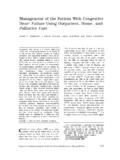Transcription of Cardiopulmonary exercise testing in patients with ...
1 REVIEWC ardiopulmonary exercise testing in patients withpulmonary arterial hypertension : an evidence-based reviewRoss arena , PhD,aCarl J. Lavie, MD,bRichard V. Milani, MD,bJonathan Myers, PhD,cand Marco Guazzi, MD, PhDdFrom theaDepartments of Internal Medicine, Physiology and Physical Therapy, Virginia Commonwealth University,Richmond, Virginia;bDepartment of Cardiovascular Diseases, Ochsner Medical Center, New Orleans, Louisiana;cCardiology Division, VA Palo Alto Health Care System, Palo Alto, California; anddCardiopulmonary Laboratory, Cardiology Division, University of Milan, San Paolo Hospital, Milan, :There is an increasing recognition of the potential value of Cardiopulmonary exercisetesting (CPX) in patients with pulmonary hypertension (PH).
2 Key CPX characteristics in these patientsinclude: (1) a diminished aerobic capacity; (2) an abnormally elevated minute ventilation carbondioxide production relationship; and (3) an abnormally diminished partial pressure of end-tidal carbondioxide. Given the burgeoning number of original research investigations utilizing CPX in patients withPH, a summation of the presently available body of literature seems :A literature search was conducted in PUBMED using Cardiopulmonary exercise testing and pulmonary arterial hypertension as key phrases. Only studies conducting exercise testing withsimultaneous ventilatory expired gas analysis in subjects with a confirmed diagnosis of pulmonaryarterial hypertension were included.
3 Twenty-three investigations were included in this review. Nineteenof the investigations assessed cohorts with resting pulmonary arterial hypertension as the sole investigations assessed subjects with chronic obstructive pulmonary disease and pulmonaryarterial hypertension : one assessed subjects with pulmonary fibrosis and pulmonary arterial hyperten-sion, and another included groups with exercise -induced pulmonary arterial hypertension and restingpulmonary arterial :Collectively, these investigations indicate variables obtained from CPX: (1) reflect varyingdegrees of PH severity.
4 (2) positively respond to several pharmacologic and surgical interventions; and(3) may provide prognostic :Currently, CPX is not widely utilized in patients with PH. Although more research isrequired in a number of areas, the present evidence-based review indicates this exercise testing techniquemay provide valuable information in the PH Heart Lung Transplant 2010;xx:xxx 2010 International Society for Heart and Lung Transplantation. All rights :expired gas;ventilation;diagnosis;prognosis;inte rventionCardiopulmonary exercise testing (CPX) employs venti-latory expired gas analysis to quantify oxygen consumption(VO2), carbon dioxide production (VCO2) and minute venti-lation (VE) both at rest and during exercise .
5 Among thewealth of information provided, this technology allows for:(1) the most accurate non-invasive assessment of aerobiccapacity; (2) determination of sub-maximal, sustained ex-ercise performance ( , ventilatory/anaerobic threshold);Reprint requests: Ross arena , PhD, Department of Physical Therapy,Virginia Commonwealth University, Health Sciences Campus, Box980224, Richmond, VA 23298-0224. Telephone: 804-828-0234. Fax: -see front matter 2010 International Society for Heart and Lung Transplantation. All rights IN PRESSand (3) assessment of ventilatory efficiency ( , matchingof pulmonary ventilation and perfusion).
6 1 CPX is presentlya well-accepted and widely utilized diagnostic test in pa-tients with heart failure (HF) and for those individualspresenting with unexplained exertional 4 Withrespect to patients with HF, there is a robust body of liter-ature demonstrating the diagnostic5 9and prognostic10 14utility of CPX as well as its ability to gauge the response 23 The body of original research supportingthe value of CPX in HF has resulted in the publication ofseveral reviews24 26and consensus 30 More recently, the potential utility of CPX in patientswith mitochondrial myopathy,31 33coronary artery dis-ease34.
7 35and suspected or confirmed pulmonary hyperten-sion (PH)36 38has garnered attention. In addition to sig-nificantly diminished aerobic capacity, these particularpatient populations present with an assortment of venti-latory expired gas abnormalities unique to each patho-physiologic process. Presently, evidence supporting theutility of CPX in patients with PH, a condition with aprevalence of 1 or 2 cases per million individuals39and ahigh short-term mortality if left untreated,40is more robustcompared with either other condition. Moreover, a state-ment jointly put forth by the American Thoracic Society andAmerican College of Chest Physicians advocates the use ofCPX during the assessment of patients with review, Diagnostics in pulmonary hypertension , by Schannwell et al,39also listed CPX as a valuable assess-ment technique in this population, although only one orig-inal research reference was cited supporting its use.
8 At thepresent time, there do not appear to be any available pub-lications providing a thorough analysis of the literaturesupporting the use of CPX in PH. Such a review is partic-ularly timely given the growing clinical interest in , the goals of this evidence-based review were to:(1) assess the pathophysiologic mechanisms accounting foran abnormal CPX response in PH; (2) describe key CPXfindings in diagnostic/comparative, interventional and prog-nostic PH investigations; (3) identify CPX variables withthe highest degree of clinical/research relevance.
9 And (4)identify current gaps in the literature, providing a basis forfuture Between PH Pathophysiology andAbnormal CPX ResponseThe ventilatory expired gas abnormalities precipitated byPH are multifactorial and associated with disease ,44 Increased pulmonary artery pressure (PAP), theprimary pathophysiologic consequence of this condition,creates a ventilation perfusion mismatch ( , acceptableventilation/diminished perfusion). This results in an in-crease in physiologic dead space, which, from a ventilatoryexpired gas perspective, is reflected by an elevated VE/VCO2ratio or slope and diminished partial pressure of end-tidalcarbon dioxide (PETCO2).
10 Increased PAP can also decreaseblood flow to the left side of the heart, resulting in a lowercardiac output (CO). The increase in PAP may shift theventricular septum leftward, negatively impacting left ven-tricular (LV) filling, which can also contribute to a decreasein CO. These secondary consequences lead to decreasedpeak VO2and VO2at the ventilatory threshold (VT) thatparallels the decline in CO. Increasing PH severity alsoeventually decreases red blood cells transit time in thepulmonary circulation to the point where oxygen diffusionis no longer able to match the needs required for a givenlevel of physical exertion.









